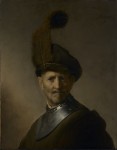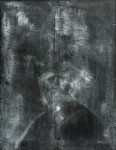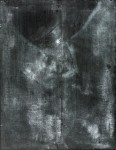 Like many artists, Dutch Golden Age painter Rembrandt van Rijn was known to have reused materials, especially in his younger days. Instead of discarding a canvas or wood panel after a false start, it’s a lot cheaper and faster to just flip it and start over again. The figure underneath An Old Man in Military Costume (1630-31) has been known to scholars since 1968 when the Rembrandt Research Project X-rayed the painting, then in the collection of Sir Brian Mountain, and found a young man’s face upside down to the right of the Old Man’s face. While the figure was visible, it was indistinct.
Like many artists, Dutch Golden Age painter Rembrandt van Rijn was known to have reused materials, especially in his younger days. Instead of discarding a canvas or wood panel after a false start, it’s a lot cheaper and faster to just flip it and start over again. The figure underneath An Old Man in Military Costume (1630-31) has been known to scholars since 1968 when the Rembrandt Research Project X-rayed the painting, then in the collection of Sir Brian Mountain, and found a young man’s face upside down to the right of the Old Man’s face. While the figure was visible, it was indistinct.
 The painting was acquired by the J. Paul Getty Museum in 1978 and it’s been studied with different imaging techniques repeatedly since then. Improvements in X-ray technology provided slightly clearer views of the man under the Man in 1978 and 2008. In 1996, neutron activation autoradiography (NAAR) was able to provide a cleaner image of the figure and, most importantly, the distribution of some of the chemical elements in the paint. If you know the chemical composition of the paint, you may be able to accurately extrapolate color, but the NAAR data was insufficient.
The painting was acquired by the J. Paul Getty Museum in 1978 and it’s been studied with different imaging techniques repeatedly since then. Improvements in X-ray technology provided slightly clearer views of the man under the Man in 1978 and 2008. In 1996, neutron activation autoradiography (NAAR) was able to provide a cleaner image of the figure and, most importantly, the distribution of some of the chemical elements in the paint. If you know the chemical composition of the paint, you may be able to accurately extrapolate color, but the NAAR data was insufficient.
 X-ray fluorescence (XRF) scanning can generate a detailed map of single-element distribution, but until recently required bulky instruments only found in select laboratories and could only scan small sections of a painting or objects small enough to fit into a cabinet unit. When the Getty first attempted an XRF scan on an area near the lips of the underlying figure, they only caught a glimpse of it. Macro-XRF (MA-XRF) technology, possible at synchrotron radiation laboratories, could scan the entire painting, but the Getty wasn’t keen to move its precious Rembrandt around the country. Just as they were exploring sending Old Man to the Stanford Synchrotron Radiation Laboratory, the development of a mobile MA-XRF scanner that could scan the painting in place made concerns about the danger and inconvenience of transporting the delicate artwork moot.
X-ray fluorescence (XRF) scanning can generate a detailed map of single-element distribution, but until recently required bulky instruments only found in select laboratories and could only scan small sections of a painting or objects small enough to fit into a cabinet unit. When the Getty first attempted an XRF scan on an area near the lips of the underlying figure, they only caught a glimpse of it. Macro-XRF (MA-XRF) technology, possible at synchrotron radiation laboratories, could scan the entire painting, but the Getty wasn’t keen to move its precious Rembrandt around the country. Just as they were exploring sending Old Man to the Stanford Synchrotron Radiation Laboratory, the development of a mobile MA-XRF scanner that could scan the painting in place made concerns about the danger and inconvenience of transporting the delicate artwork moot.
Now a new study combines the new mobile MA-XRF scanning technology with data from the early NAAR scans to reveal the most complete image of the young man yet.
The general shape of the face of the figure underlying An Old Man in Military Costume was revealed by X-radiography: NAAR imaging provided more details about the shape of the face and the cloak worn by the figure along with indications of the chemical composition of some of the pigments Rembrandt used. MA-XRF scanning significantly added to the understanding of the hidden painting by providing detailed images of the distribution of individual chemical elements, from which the specific pigment(s) – and colors – Rembrandt used to paint the first figure could be inferred. For example, the underlying figure’s face is rich in the element mercury, indicative of the presence of the red pigment vermilion, one of the components used to create flesh tones. The MA-XRF map of mercury provided a nearly complete, detailed image of the face of the underlying figure; similarly, the map of copper, typically associated with blue or green pigments, provided an image of the cloak.
Together, the information from the NAAR and MA-XRF scans was used to create a tentative digital color reconstruction of the hidden image: a young man, seen in three-quarter view wearing a voluminous cloak around his shoulders. The full significance of the hidden painting within Rembrandt’s oeuvre will continue to be the subject of ongoing research.
One possibility that will be studied further is that the underlying image is a self-portrait. Rembrandt often used his own face in his early character studies and it’s likely this young man is the artist as a young man. The study has been published in the journal Applied Physics A and can be read in its entirety for free here.
By the only criterion that matters (i.e. the pleasure they give me) my top 3 artists are (in no particular order)
1 Turner, 2 Rembrandt, and 3 a bunch of other Dutchmen of about that period.
I imagine Rembrandt watching from the afterlife and shouting, “No, you fools, it’s no good! That’s why I painted over it! STOP LOOKING AT THAT!”
Just what I was thinking, Karen! (laughing)
I don’t think I’ve ever seen “Old Man in Military Costume” before. This story was worth it just to see how beautiful that painting is, let alone the hidden one beneath.
Old Man in Military Costume is excellent! So life-like! (He doesn’t look much older than me, though.)
The “hidden” figure pales in comparison. I agree with Karen. Rembrandt didn’t intend that one to see the light of day.
We humans get curious about the oddest things, don’t we?